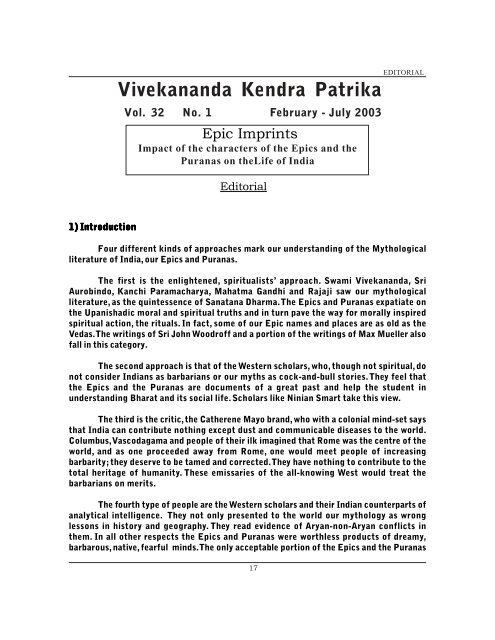Epics in Imprints-1.pdf - Vivekananda Kendra Prakashan
Epics in Imprints-1.pdf - Vivekananda Kendra Prakashan
Epics in Imprints-1.pdf - Vivekananda Kendra Prakashan
You also want an ePaper? Increase the reach of your titles
YUMPU automatically turns print PDFs into web optimized ePapers that Google loves.
1) 1) Introduction<br />
Introduction<br />
<strong>Vivekananda</strong> <strong>Kendra</strong> Patrika<br />
Vol. 32 No. 1 February - July 2003<br />
Epic Impr<strong>in</strong>ts<br />
Impact of the characters of the <strong>Epics</strong> and the<br />
Puranas on theLife of India<br />
Editorial<br />
17<br />
EDITORIAL<br />
Four different k<strong>in</strong>ds of approaches mark our understand<strong>in</strong>g of the Mythological<br />
literature of India, our <strong>Epics</strong> and Puranas.<br />
The first is the enlightened, spiritualists’ approach. Swami <strong>Vivekananda</strong>, Sri<br />
Aurob<strong>in</strong>do, Kanchi Paramacharya, Mahatma Gandhi and Rajaji saw our mythological<br />
literature, as the qu<strong>in</strong>tessence of Sanatana Dharma. The <strong>Epics</strong> and Puranas expatiate on<br />
the Upanishadic moral and spiritual truths and <strong>in</strong> turn pave the way for morally <strong>in</strong>spired<br />
spiritual action, the rituals. In fact, some of our Epic names and places are as old as the<br />
Vedas. The writ<strong>in</strong>gs of Sri John Woodroff and a portion of the writ<strong>in</strong>gs of Max Mueller also<br />
fall <strong>in</strong> this category.<br />
The second approach is that of the Western scholars, who, though not spiritual, do<br />
not consider Indians as barbarians or our myths as cock-and-bull stories. They feel that<br />
the <strong>Epics</strong> and the Puranas are documents of a great past and help the student <strong>in</strong><br />
understand<strong>in</strong>g Bharat and its social life. Scholars like N<strong>in</strong>ian Smart take this view.<br />
The third is the critic, the Catherene Mayo brand, who with a colonial m<strong>in</strong>d-set says<br />
that India can contribute noth<strong>in</strong>g except dust and communicable diseases to the world.<br />
Columbus, Vascodagama and people of their ilk imag<strong>in</strong>ed that Rome was the centre of the<br />
world, and as one proceeded away from Rome, one would meet people of <strong>in</strong>creas<strong>in</strong>g<br />
barbarity; they deserve to be tamed and corrected. They have noth<strong>in</strong>g to contribute to the<br />
total heritage of humanity. These emissaries of the all-know<strong>in</strong>g West would treat the<br />
barbarians on merits.<br />
The fourth type of people are the Western scholars and their Indian counterparts of<br />
analytical <strong>in</strong>telligence. They not only presented to the world our mythology as wrong<br />
lessons <strong>in</strong> history and geography. They read evidence of Aryan-non-Aryan conflicts <strong>in</strong><br />
them. In all other respects the <strong>Epics</strong> and Puranas were worthless products of dreamy,<br />
barbarous, native, fearful m<strong>in</strong>ds. The only acceptable portion of the <strong>Epics</strong> and the Puranas

















